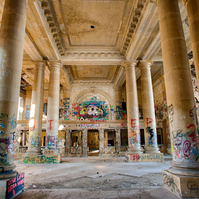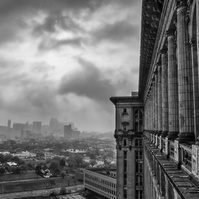Ford Michigan Central Station in Detroit Michigan
Detroit, once known as the Motor City, has witnessed a remarkable transformation over the years. In the heart of this historic city lies a symbol of its past glory and its future potential: the Ford Michigan Central Station. Once a thriving transportation hub, this architectural masterpiece fell into disrepair and abandonment, becoming a poignant reminder of Detroit’s economic decline. However, in a remarkable turn of events, Ford Motor Company stepped in to revive this iconic landmark, breathing new life into both the building and the city itself.
Michigan Central Station, designed by the renowned architectural firm Warren & Wetmore, opened its doors in 1913. A magnificent Beaux-Arts structure, it stood as a testament to Detroit’s prominence in the early 20th century. For decades, it served as a bustling train station, witnessing the comings and goings of countless travelers. However, with the rise of automobiles and the decline of rail travel, the station’s relevance diminished, leading to its closure in 1988.
In 2018, Ford Motor Company acquired the Michigan Central Station with a grand vision in mind. The company aimed to transform the building into a vibrant innovation hub, bringing together engineers, designers, and entrepreneurs to shape the future of mobility. This bold move marked Ford’s commitment to Detroit’s revitalization and its determination to be at the forefront of automotive innovation.
Restoring a century-old structure is no small feat, but Ford approached the challenge with unwavering dedication. The restoration process involved extensive research, meticulous planning, and collaboration with architects, historians, and preservation experts. Ford aimed to preserve the building’s original grandeur while incorporating modern amenities and sustainable features.
The restoration project included repairing the deteriorated masonry, restoring the iconic waiting room, and reinstating the building’s stunning exterior façade. Additionally, Ford embraced sustainability by incorporating energy-efficient technologies, green spaces, and transportation alternatives into the design. The company’s commitment to preserving the historical integrity of Michigan Central Station while adapting it for the needs of the future sets a precedent for urban revitalization projects.
The revival of Michigan Central Station has sparked a ripple effect throughout the city. Ford’s investment in the building has brought renewed hope and optimism to Detroit, symbolizing a turning point in its revitalization efforts. The project has provided a significant economic boost, creating jobs and attracting new businesses to the area. Furthermore, the influx of creative minds into the innovation hub has fostered a vibrant entrepreneurial ecosystem, fostering collaboration and innovation in the heart of Detroit.
The restoration of Michigan Central Station is more than just a physical transformation; it represents a catalyst for community development. Ford has actively engaged with local residents, seeking their input and incorporating their ideas into the project. The company has also partnered with community organizations to provide training, job opportunities, and support for Detroit’s residents.
As the restoration nears completion, the future of Michigan Central Station appears brighter than ever. Ford envisions the building as a dynamic mixed-use space, housing not only its own employees but also startups, small businesses, retail outlets, and community amenities. The surrounding neighborhood is also undergoing a resurgence, with new housing developments and public spaces being planned to complement the revived station.
The resurrection of Ford Michigan Central Station stands as a testament to the power of visionary leadership and the resilience of a city. With its rich history, meticulous restoration, and commitment to community engagement, this project represents far more.




